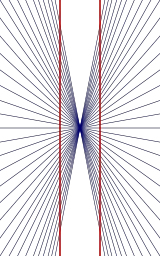Difference between revisions of "Hering illusion" - New World Encyclopedia
(started) |
|||
| Line 7: | Line 7: | ||
[[Image:Hering illusion.svg|thumb|right|160px|'''Hering illusion''']] | [[Image:Hering illusion.svg|thumb|right|160px|'''Hering illusion''']] | ||
| − | The '''Hering illusion''' is an [[optical illusion]] discovered | + | The '''Hering illusion''' is an [[optical illusion]] discovered in 1861. The two vertical lines are both straight, but they look as if they were bowed outwards. The [[Orbison illusion]] is a variant of the Hering illusion, as is the [[Wundt illusion]]. |
| + | ==Discovery== | ||
| + | The Hering illusion is named for the German physiologist [[Ewald Hering]], who first published the illusion in 1861. | ||
| + | ==Description== | ||
| + | When looking at the illusion, the viewer appears to see a pair of bowed or curved lines placed in front of a series of other lines. In reality, these bowed lines are [[parallel]], and only appear to be curved. | ||
| + | |||
| + | ==Explanation== | ||
| + | The effect of the Hering illusion is often attributed to "angular displacement", where the perception of the straight parallel lines is skewed because of the effect of the angular lines surrounding them.<ref>[http://www.csun.edu/~ata20315/hering.htm "The Hering Illusion"] California State University at Northridge. Retrieved October 2, 2007.</ref> The distortion may also be produced by the lined pattern on the background, which simulates a perspective design and creates a false impression of depth. | ||
| + | |||
| + | It has been observed that the illusion takes place when the image is horizontal or vertical, but is decreased when the image is rotated at an angle. This discovery has challenged traditional theories about how the illusory effect is generated.<ref>Zhang, Jinfu and Xiaolin Liu. [http://findarticles.com/p/articles/mi_m2405/is_n4_v121/ai_16349889 "Discovery and a preliminary study of the parallel lines illusion change effect"] October 1994. Journal of General Psychology. Retrieved October 2, 2007.</ref> | ||
| + | |||
| + | ==Applications== | ||
| + | Like many perceptual illusions, the Hering illusion helps neuroscientists study the mechanisms of perception. | ||
{{Credits|Hering_illusion|115471677|}} | {{Credits|Hering_illusion|115471677|}} | ||
Revision as of 19:11, 2 October 2007
The Hering illusion is an optical illusion discovered in 1861. The two vertical lines are both straight, but they look as if they were bowed outwards. The Orbison illusion is a variant of the Hering illusion, as is the Wundt illusion.
Discovery
The Hering illusion is named for the German physiologist Ewald Hering, who first published the illusion in 1861.
Description
When looking at the illusion, the viewer appears to see a pair of bowed or curved lines placed in front of a series of other lines. In reality, these bowed lines are parallel, and only appear to be curved.
Explanation
The effect of the Hering illusion is often attributed to "angular displacement", where the perception of the straight parallel lines is skewed because of the effect of the angular lines surrounding them.[1] The distortion may also be produced by the lined pattern on the background, which simulates a perspective design and creates a false impression of depth.
It has been observed that the illusion takes place when the image is horizontal or vertical, but is decreased when the image is rotated at an angle. This discovery has challenged traditional theories about how the illusory effect is generated.[2]
Applications
Like many perceptual illusions, the Hering illusion helps neuroscientists study the mechanisms of perception.
Credits
New World Encyclopedia writers and editors rewrote and completed the Wikipedia article in accordance with New World Encyclopedia standards. This article abides by terms of the Creative Commons CC-by-sa 3.0 License (CC-by-sa), which may be used and disseminated with proper attribution. Credit is due under the terms of this license that can reference both the New World Encyclopedia contributors and the selfless volunteer contributors of the Wikimedia Foundation. To cite this article click here for a list of acceptable citing formats.The history of earlier contributions by wikipedians is accessible to researchers here:
The history of this article since it was imported to New World Encyclopedia:
Note: Some restrictions may apply to use of individual images which are separately licensed.
- ↑ "The Hering Illusion" California State University at Northridge. Retrieved October 2, 2007.
- ↑ Zhang, Jinfu and Xiaolin Liu. "Discovery and a preliminary study of the parallel lines illusion change effect" October 1994. Journal of General Psychology. Retrieved October 2, 2007.
